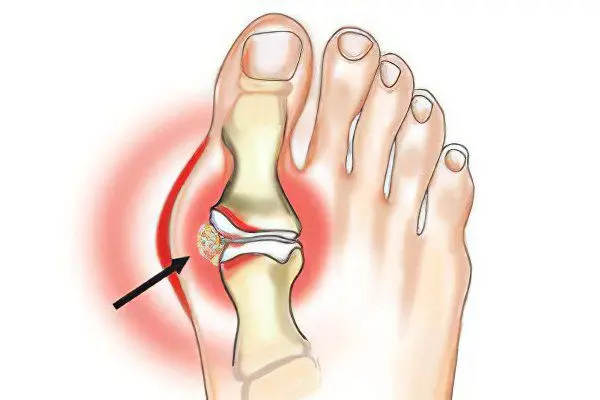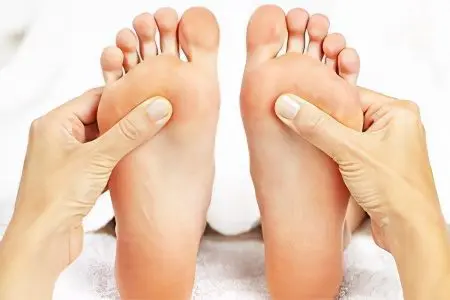Contents
Arthritis of the toes – This is an inflammatory disease, manifested by damage to the corresponding joints. In some types of arthritis, patients suffer not only from the joints, but also from internal organs – the heart, kidneys, liver.
Often, arthritis leads to disability. Therefore, it is so important to seek help from a specialist at the first signs of the disease.
In the vast majority of cases, arthritis of the toes begins to develop in both men and women after the age of 60. However, some types of arthritis can occur even in early childhood.
Symptoms of Arthritis of the Toes

Each arthritis has its own characteristics, but these diseases are united by common symptoms:
Night pains. For any type of arthritis, a special pain regimen is characteristic: pain in inflamed joints occurs at rest at night – usually between 3 and 5 o’clock in the morning;
Swelling of the joints. Inflammation of any of the four toes, except for the big one, most often occurs with rheumatoid arthritis. In this case, the joints of the lower extremities always become inflamed symmetrically (for example, both little fingers);
Reactive arthritis, which begins with inflammation of the joints of the big toes or adjacent second toes;
Gouty arthritis, one of the first signs of which is unbearable pain in the toes;
For psoriatic and less commonly reactive arthritis sore fingers swell from tip to base and look like sausages;
Skin changes over sore joints. Almost always, the skin over the affected joints turns red or bluish in color and becomes hot to the touch.
In some cases, patients may also have other accompanying symptoms of arthritis of the toes:
Moderate increase in body temperature up to 38C (usually with rheumatoid or reactive arthritis);
Chills;
Conjunctivitis (an additional symptom of reactive arthritis);
feeling of weakness;
restless sleep, insomnia;
Loss of appetite, weight loss (with rheumatoid arthritis).
As any arthritis develops without adequate treatment, patients experience irreversible deformity of the joints of the toes.
Causes of Arthritis of the Toes
Depending on the type of arthritis, one or more of the following reasons may serve as an impetus for its development:
Hereditary factor. This predisposition to the disease is characteristic of psoriatic and gouty arthritis. But, despite this, in patients with gout, the disease may not manifest itself at all if they lead a healthy lifestyle. And they can provoke the development of gouty arthritis by the abuse of alcohol or “purine” products (meat, meat soups, offal, beans, chocolate, wine);
Infections. This factor in the development of the disease is characteristic of reactive and rheumatoid arthritis. Most often, reactive arthritis is the result of latent genital infections. The development of rheumatoid arthritis is also based on infections, but here influenza, tonsillitis, acute respiratory infections are most often provocateurs;
Injuries. The cause of arthritis of the toe can be transferred household injuries – dislocations, fractures. “Professional” arthritis can occur in athletes, dancers, etc.;
Leg load. Arthritis can be triggered by increased pressure on the joints due to excess weight, regular weight lifting, improperly selected shoes, flat feet;
Chronic stress. In combination with an infectious disease or injury, stress can be a trigger in the development of psoriatic or rheumatoid arthritis.
Treatment of arthritis of the toes

For the treatment of arthritis, a whole range of drugs is used:
Nonsteroidal anti-inflammatory drugs (NSAIDs) (ibuprofen, diclofenac, indomethacin, etc.). These drugs help reduce inflammation and pain in the joints;
Chondroprotectors (glucosamine, chondroitin sulfate, arthra, arthroflex, chondro, etc.). These drugs contain substances that help restore the structure of damaged cartilage of the joints;
Compresses (dimexide, bischofite, medical bile). They are used externally to reduce inflammation in the joints, for a mild analgesic effect and as a warming agent.
In the course of treatment for some arthritis, additional drugs may be prescribed by the attending physician: for example, corticosteroids, immunosuppressants, or other drugs.
With rheumatoid and gouty arthritis of the toes, in addition to medicines, patients are prescribed a special diet. In these diseases, there is a clear relationship between the use of certain types of products and the exacerbation of the inflammatory process.
With rheumatoid arthritis, doctors recommend limiting, and it is better to exclude wheat, corn, citrus fruits, and dairy products from the diet. It is useful for patients to eat fish, seafood, vegetables, fruits, buckwheat and some other products.
Patients with gout are strongly advised to exclude or severely limit the consumption of meat, sausages, canned food, any broths (except vegetable), fatty fish, legumes, sour varieties of vegetables, chocolate, coffee, tea, alcoholic beverages.
After the removal of inflammation, with persistent remission, some types of physiotherapy may be recommended for patients with arthritis of the toes: therapeutic mud, paraffin therapy, etc. In the absence of contraindications, therapeutic massage and / or therapeutic exercises can also be prescribed.
Arthritis is a serious inflammatory disease that, if left untreated, can lead to disability. Timely diagnosis, seeking advice from a rheumatologist and properly prescribed treatment allow patients to stop the disease and lead their usual lifestyle for many years to come.









